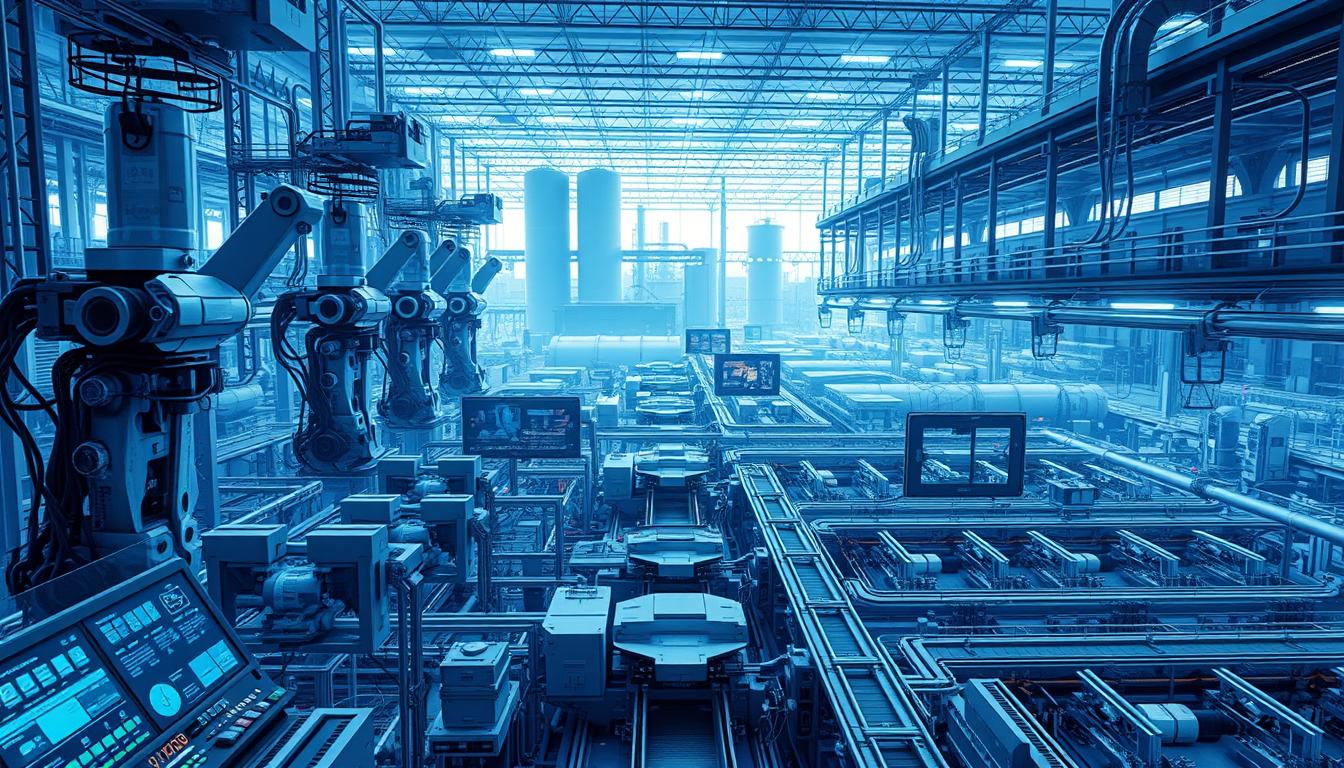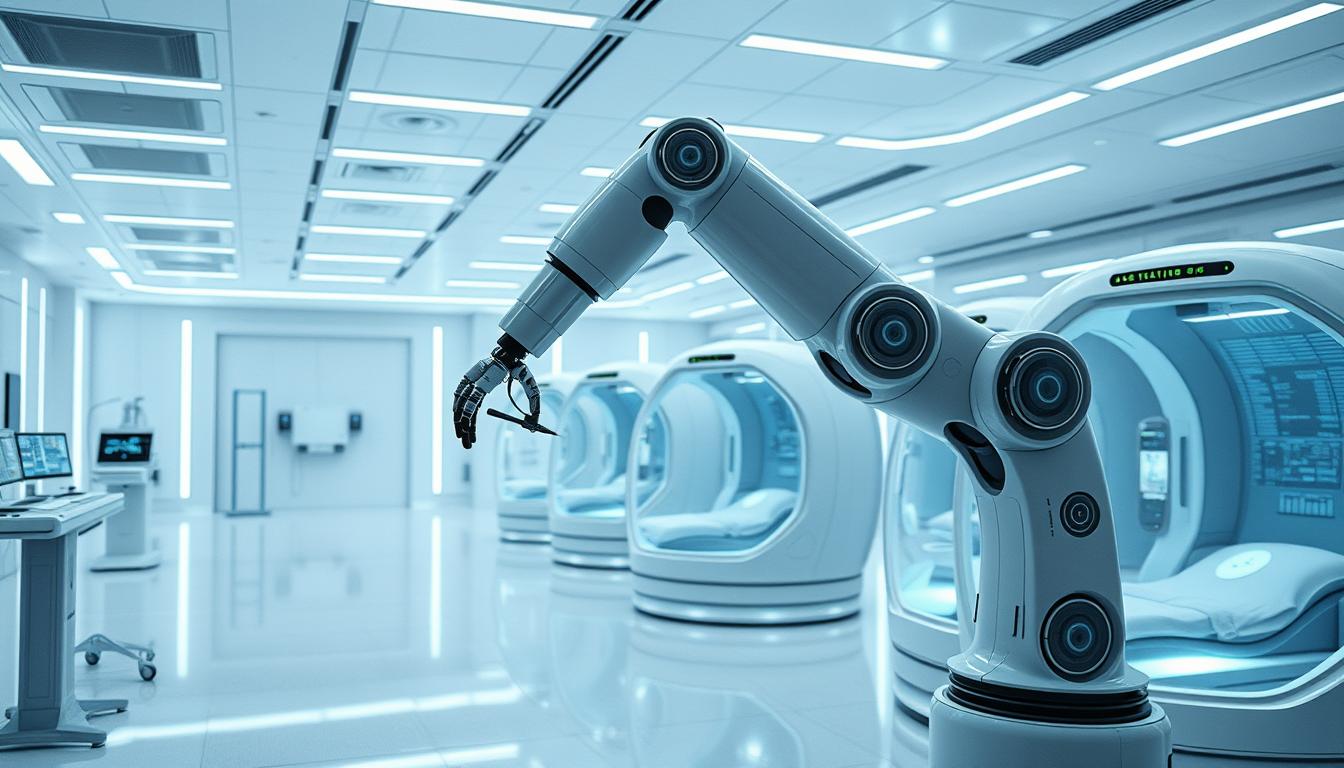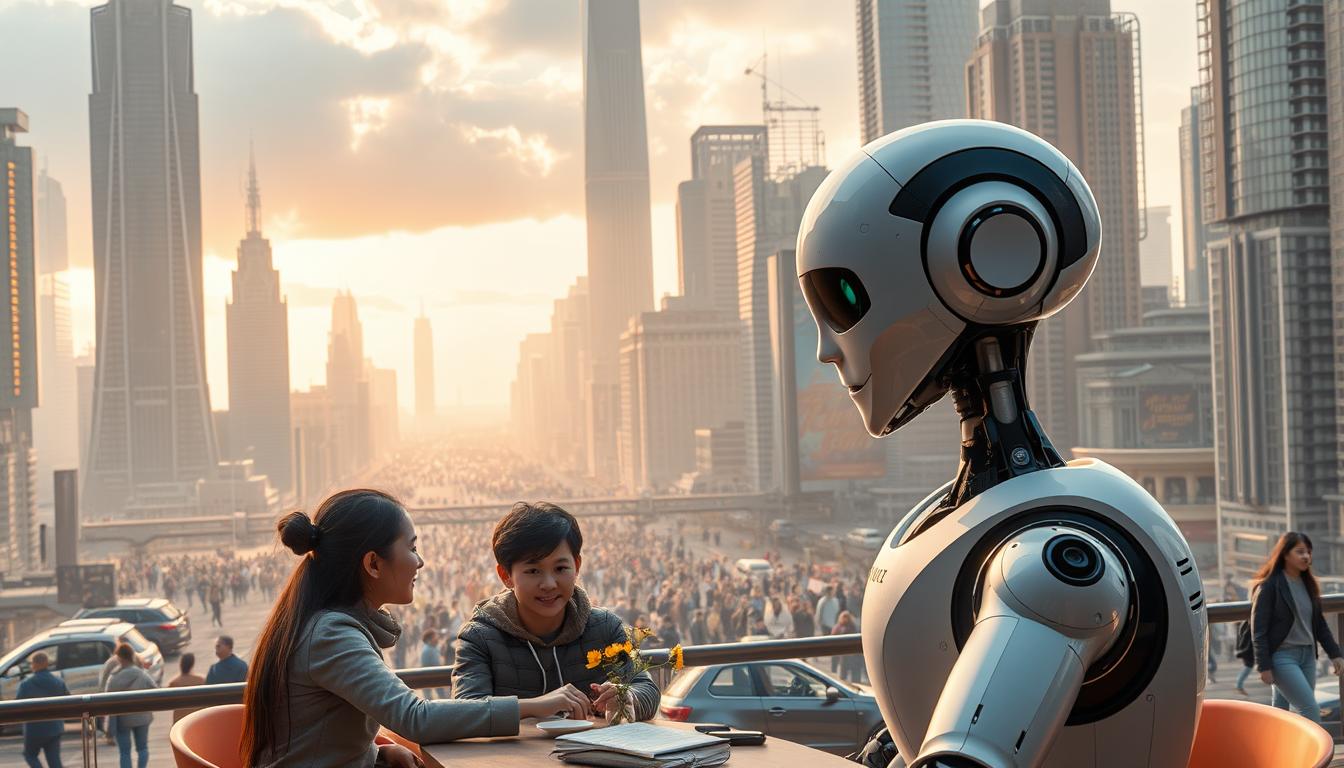

We are seeing big changes in many industries because of fast progress in robotics and related tech.
New tech like artificial intelligence and digital twins is changing things. It’s making things cheaper, more efficient, and helping companies stay ahead.
These new ideas are not just making old processes better. They’re also opening up new ways of doing things in the industry4.0 era.
Key Takeaways
- The mix of robotics and artificial intelligence is changing industries.
- Technologies like digital twins are making things run smoother.
- New ideas are cutting costs and helping companies compete better.
- The industry4.0 era is bringing new chances.
- Robotics is a big part of the change in many fields.
The Current State of Industrial Robotics
We are entering a new era of robotics, and it’s key to know where we stand. The field is moving fast towards more advanced and self-operating systems. This change comes from the use of artificial intelligence (AI) and machine learning (ML).
From Assembly Lines to Autonomous Systems
Industrial robotics has grown from simple assembly lines to complex autonomous systems. This change aims to boost efficiency, precision, and flexibility in making things.
Historical Context and Recent Acceleration
Robots used to just do the same tasks over and over. But now, with AI and ML, they can interpret data, make quick decisions, and even predict when they need a check-up. By 2025, we’ll see more AI-powered robots, making factories work better than ever.
Key Technologies Driving the Robotics Revolution
Several technologies are leading the robotics revolution. AI, machine learning, and advanced sensors are making robots smarter, more flexible, and able to tackle complex tasks.
AI, Machine Learning, and Advanced Sensors
AI and ML are taking robotics to new levels. By 2025, AI robots will understand data, make fast decisions, and even predict when they need a check-up. Advanced sensors help robots see and understand their surroundings, making better choices.
As we keep exploring robotics, we’ll see big improvements soon. These advancements will come from the ongoing growth of these key technologies.
How Robotics is Revolutionizing Manufacturing
The manufacturing world is changing fast, thanks to robotics and Industry4.0. It’s key to know what’s driving this change and how it’s affecting the industry.
Smart Factories and Industry4.0 Integration
At the core of Industry4.0 is the idea of smart factories. Here, artificial intelligence, robotics, and the Internet of Things (IoT) work together. They make manufacturing more efficient and adaptable.
Real-Time Data and Predictive Maintenance
Smart factories are great at using real-time data. This data helps with predictive maintenance. It lets manufacturers know when equipment might fail, so they can fix it before it breaks down. This cuts down on downtime and boosts productivity.
Collaborative Robots Reshaping Human-Machine Interaction
Collaborative robots, or cobots, are special because they can work with humans. They’re perfect for small businesses and changing environments. This new way of working together is changing how humans and machines interact, making it safer and more efficient.
Case Studies from American Manufacturing Leaders
Many American manufacturing leaders have started using collaborative robots. They’ve seen big benefits, like better production flexibility and lower labor costs. Here are some examples:
- Automotive makers using cobots on assembly lines
- Aerospace companies for precise tasks
- Small businesses boosting their production with cobots
These stories show how cobots can change the manufacturing world.
Expanding Robotics Applications Across Sectors

Robotics technology is getting better and better. It’s now used in many areas, changing how we work. It’s making healthcare, agriculture, logistics, and the service industry better and more efficient.
Healthcare and Medical Robotics Innovations
The healthcare world is changing fast with robotics. Medical robotics is making surgeries more precise and patient care better. It’s helping patients recover faster and get better care overall.
Surgical Systems and Patient Care Automation
Surgical robots help with complex surgeries, making them less invasive. They allow for more precise work, like dissections and suturing. This leads to less blood loss and quicker healing for patients. Also, robots help with tasks like giving medicine and checking vital signs, so doctors can focus on patients more.
Agricultural and Logistics Transformation
In farming, robotics is changing how we grow crops. Agricultural robotics makes farming more efficient and cuts down on costs. In logistics, robots are making warehouses run better and faster.
From Field to Warehouse: End-to-End Automation
Robotics is making farming and logistics work together better. From tractors and drones in fields to robots in warehouses, it’s making the supply chain smoother. This means products get to customers faster and cheaper.
Service Industry Disruption
The service industry is also seeing big changes with robotics. Robots are helping in retail, hospitality, and tourism. Service robots can greet customers, give information, and even help with payments.
Customer-Facing Robotics Solutions
Robots are becoming a common sight in public places. They help people, provide information, and even entertain. For example, robots help with daily tasks in elder care and support for people with disabilities, making life easier and more enjoyable.
As we keep exploring robotics in different fields, it’s clear it’s making things better. It’s not just making things more efficient but also opening up new ways to innovate and connect with customers.
The Societal Impact of Accelerated Robotics Adoption

Robots are getting smarter and more common, which is changing society for the better and worse. As we add robots to more areas, we must think about how they affect us all.
Workforce Evolution and Skills Gap
Robots are changing the job market, making some jobs obsolete. Now, people need new skills to keep up. This skills gap is a big problem for everyone.
Retraining Programs and New Job Categories
To fix the skills gap, retraining programs are key. They teach workers how to work with robots. Also, robots are creating new job categories like robotics engineers.
Ethical Considerations and Policy Challenges
With more robots around, we face big ethical considerations. We must think about privacy, who’s to blame, and jobs lost. Governments and groups are working on policy challenges to handle these issues.
Developing Responsible Robotics Frameworks
Creating responsible robotics frameworks is vital. It helps us enjoy the good parts of robots while avoiding the bad. This requires teamwork between policymakers, business leaders, and ethicists.
Our Perspective on Balancing Progress with Responsibility
We think it’s key to balance technological progress with social responsibility. We need to invest in robotics and also in programs that help society. This way, robots can help make our future better and fairer.
Embracing the Future of Robotics
The robotics industry in 2025 is all about innovation, adaptability, and being green. It promises to change industries and how we work.
We’ve seen how robotics is changing manufacturing and growing in other areas. It’s clear that robotics is leading the way in making industries better. We need to keep improving robotics to make sure humans and machines work well together.
As robotics grows faster, we must think about its impact on society. We need to make sure progress goes hand in hand with responsibility. The future of robotics will depend on how well we use its power and solve its problems.
FAQ
What is the role of artificial intelligence in industrial robotics?
Artificial intelligence is key in industrial robotics. It lets robots learn, decide, and adapt. This boosts efficiency and productivity.
How are digital twins being used in robotics?
Digital twins are virtual copies of robots and systems. They help in simulating and optimizing before real-world use.
What is Industry 4.0, and how is it related to robotics?
Industry 4.0 is the fourth industrial revolution. It combines digital, physical, and biological systems. Robotics is central to it, making smart factories and automating manufacturing.
How are collaborative robots changing human-machine interaction?
Collaborative robots, or cobots, work with humans. They use advanced sensors and AI to interact safely and efficiently.
What are some examples of robotics applications in healthcare?
Healthcare uses robots for surgery, assistants, and rehab. They improve care, reduce recovery times, and enhance quality.
How is robotics transforming the agricultural sector?
Robotics automates tasks like monitoring, harvesting, and managing livestock. It boosts efficiency, cuts costs, and helps farmers make better decisions.
What are the ethical considerations surrounding the adoption of robotics?
Robotics raises ethical concerns like job loss, AI bias, and safety. We must address these to ensure responsible use.
How can workers adapt to the changing robotics landscape?
Workers need new skills as robotics evolves. This includes training in AI, machine learning, and data analysis.
What is the future of robotics, and how will it impact various industries?
Robotics’ future is bright, driven by AI and machine learning. It will deeply influence industries like manufacturing, healthcare, and logistics.
RELATED POSTS
View all


